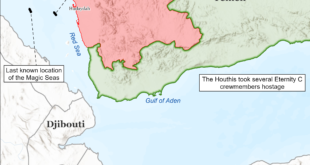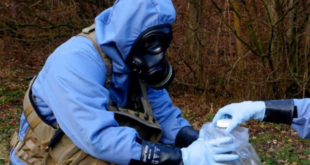Russia declared what it described as a “federal-level” emergency on August 9 in the Kursk region, the site of a four-day incursion by Ukrainian forces. The announcement came hours after a Ukrainian military strike on an airfield there.
In response to the incursion, the Russian Defense Ministry said on August 9 that it was transferring extra forces to the region, including Grad multiple-launch rocket systems, artillery, and tanks, Interfax reported.
State-run media reported on troops and armor being redeployed to Kursk, including video of Russian military on the move, much of it reposted on social media.
The cross-border action in Russia’s Kursk region has been described as the biggest attack on Russian soil since Russian President Vladimir Putin launched his country’s unprovoked, full-scale invasion of Ukraine in February 2022.
Much remains unclear, including the number of Ukrainian soldiers taking part, although the Russian military has claimed it involves some 1,000 troops and more than two dozen armored vehicles and tanks.
Since the start of the incursion on August 6, Ukrainian troops have seized control of about 600 square kilometers of territory, and more than two dozen settlements, according to local officials, pro-war bloggers, and open-source intelligence reports.
Ukrainian officials have not officially confirmed the operation, but Ukrainian President Volodymyr Zelenskiy said in his evening address on August 8 that Russia needed to “feel” the consequences of its invasion.
“Russia brought the war to our land and should feel what it has done,” Zelenskiy said, without directly referring to the offensive.
Ukrainian soldiers appeared in a video late on August 9 showing a Ukrainian flag against the backdrop of a Gazprom facility in Sudzha, a town just over the border in the Kursk region. In the video, which was posted on Ukrainian media, one of the soldiers says that Sudzha and the Gazprom facility is controlled by Ukrainian forces.
“The news is as follows. The city is controlled by the armed forces of Ukraine. The strategic object of Gazprom in Sudzha is controlled by the 99th Mechanized Battalion,” the fighters say in the video, which could not be immediately verified.
Sudzha Mayor Vitaly Slashchev denied the claim in a comment to TASS but said an evacuation of the city was under way.
A Ukrainian member of parliament who spoke with RFE/RL on August 9 said the Ukrainian military was “advancing and making an impression on the enemy” and inflicting damage on Russian forces in the Kursk region.
“And the most important thing is that they are advancing quite professionally,” lawmaker Roman Kostenko said, adding that they had managed to surprise the enemy at a place where the Russian forces were the weakest.
Earlier on August 9 the Ukrainian military said it had hit the airfield in Russia’s southern Lipetsk region overnight, damaging guided-bomb stockpiles.
“Several sources of ignition were recorded, a large fire broke out and multiple detonations were observed,” Kyiv’s military said on the Telegram messaging app.
It said Russian Su-34, Su-35 and MiG-31 aircraft were based at the airfield.
Russian media, including TASS, reported a fire at the military airfield in the Lipetsk region, which is west of the Kursk region, the site of the ongoing incursion. The reports gave no cause for the blaze.
Those reports came hours after regional Governor Igor Artamonov said on social media that Lipetsk had hit by a massive drone attack. He later added that a local power installation had been damaged and six people had been wounded.
Artamonov first urged residents to ignore calls on social media to evacuate, saying they were being “spread by the enemy in order to sow panic.” Hours later, he said a state of emergency had been declared in the Lipetsk district and that four outlying settlements of Lipetsk city had been ordered to evacuate.
Satellite images made available to RFE/RL by Planet Labs show the consequences of Ukrainian strikes on the Lipetsk airfield. The unverified images show completely destroyed buildings and evidence of a large fire. Two craters — possibly the result of missile or drone strikes — are also visible.
The head of the UN’s nuclear watchdog, Rafael Grossi, has urged Ukraine and Russia to show restraint in the fighting in the Kursk region, site of one of Russia’s largest nuclear power stations.
“At this juncture, I would like to appeal to all sides to exercise maximum restraint in order to avoid a nuclear accident with the potential for serious radiological consequences,” Grossi said in a statement.
Russia’s diplomatic mission in Vienna, quoted by Russian news agencies, said it had told the International Agency for Atomic Energy (IAEA) that fragments had been found at the station, possibly from downed missiles, but there was no evidence of any direct attack on the facility.
Elsewhere, unconfirmed reports spoke of a Russian column having been destroyed in the Kursk region with many casualties. Video circulating on social media showed what appeared to be many burned-out military transport vehicles on the side of a road in or near the town of Rylsk.
Two ethnic Armenians in Kursk who spoke with RFE/RL’s Armenian Service by phone said the Russian authorities had banned large gatherings and mass events in the region through August 11.
“It can be said that we are at war now,” said one of the men, who spoke on the condition of anonymity.
He said Ukrainian troops had captured two towns that are 60 to 70 kilometers away from the city of Kursk in addition to the Gazprom facility.
“The main fighting now is around the towns of Sudzha, Lgov, and Korenevo. People have been evacuated from these areas. We are inside Kursk. And there is always a risk of missile attacks here. This is how we live.”
He said that there had been no evacuation from the city of Kursk yet, but noted that air-raid alerts were frequent, entertainment venues were closed, and public transportation had been disrupted by missile and drone strikes.
“Warplanes, missiles are flying overhead. Air-raid alerts are issued every half-hour. But we are kind of used to it, given what has been going on for the past year or two. No one takes cover because every half-hour missiles or drones strike,” he added.
Separately, the governor of the Russian-held city of Sevastopol on Ukraine’s occupied Crimea Peninsula, Mikhail Razvozhayev, said on Telegram that Russian forces destroyed three drones and three drone boats near the city.
The Russian Defense Ministry said a total of 75 Ukrainian drones were destroyed over Russia overnight, according to the RIA Novosti news agency, most of them over the Belgorod and Lipetsk regions.
 Eurasia Press & News
Eurasia Press & News

